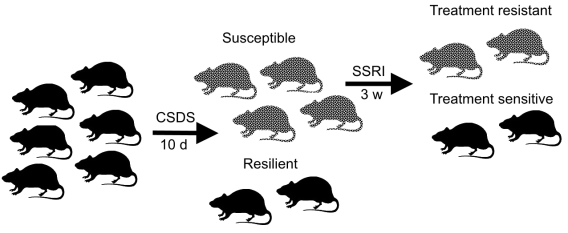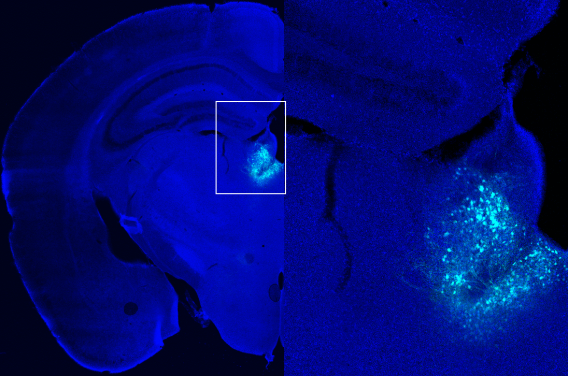Mouse models of treatment resistant depression
Using a valid animal model is essential for the discovery of effective novel treatments. Chronic social defeat stress (CSDS) is a widely used model of individual differences in response to stress in which rodents are subjected to repeated bouts of defeat. This protocol produces subgroups of “resilient” and “susceptible” mice and has enabled the investigation of stress susceptibility. We have extended this model to develop an approach to study treatment resistant depression. We find that treatment sensitive and treatment resistant subgroups emerge after chronic treatment of “susceptible” mice with the antidepressant fluoxetine, a commonly prescribed selective serotonin reuptake inhibitor (SSRI). The presence of two subgroups of animals mimics the human response to antidepressant treatment. With this paradigm, the mechanism of treatment resistance can be explored by comparing the treatment resistant and treatment sensitive subgroups. Furthermore, novel therapeutic approaches for treatment resistant depression can be validated in treatment resistant animals.
In addition to the CSDS model, we are also exploring treatment resistance in the context of the corticosterone model of rodent depression-like behavior. We plan to extend both of these models to study treatment resistance in female mice as well, since female sex is a risk factor for affective disorders like depression.

The role of the lateral habenula in treatment resistant depression
Several brain regions have been implicated in depression; however, the lateral habenula is a particularly appealing target for several reasons. Anatomically, it serves as a monoaminergic hub via its connections to dopaminergic and serotonergic loci. In addition to its anatomical targets, the lateral habenula has been demonstrated to serve a role in value-based decision-making. Lateral habenula neurons are more active during punishment or following the absence of an expected reward. In this manner, lateral habenula activity signals the negative valence associated with a decision. Moreover, increased activity of the lateral habenula is seen in response to chronic stress. In humans, positron emission tomography has been used to demonstrate that lateral habenula activity is associated with depressed mood. In rodents, inhibition of the lateral habenula has been shown to reverse social withdrawal and despair seen in animals subjected to chronic stress. Finally, modulation of the lateral habenula with deep brain stimulation has been demonstrated to be an effective therapy in a patient with treatment resistant depression. For these reasons, we are targeting the lateral habenula to characterize its role in treatment resistance. The figure to the right demonstrates expression of green fluorescent protein following viral injection targeting the lateral habenula. We plan to use viral-based strategies to manipulate lateral habenula activity and determine the role of the lateral habenula in the setting of treatment resistance.

Using tractography to investigate lateral habenula connectivity in humans
The lateral habenula is an epithalamic brain region that is an important target for depression. To therapeutically modulate the lateral habenula, its anatomy must be characterized and targeted. Predominant inputs include the ventral pallidum/globus pallidus internus, and predominant outputs include the ventral tegmental area. Rodent studies have demonstrated that these inputs mediate depression-like behavior. We recently used diffusion magnetic resonance imaging to reconstruct these tracts and revealed sex and hemispheric differences in streamline counts in healthy subjects (see adjacent figure). In ongoing work, we plan to study these tracts in patients with depression. Using our unique dataset, we will determine if any depression biotypes or if treatment resistance is associated with differences in lateral habenula tract anatomy. This may hint at which patient populations would benefit most from lateral habenula modulation. These data are desperately needed, because no clear methods exist to determine the optimal neuromodulatory target in a disease as heterogenous as treatment resistant depression.

Other projects, collaborations
While the primary focus of our lab is the investigation of treatment resistant depression, we have a diverse array of research interests in areas relevant to functional neurosurgery such as movement disorders. Additionally, Dr. Hitti participates in several clinical trials for neurological and psychiatric conditions. If you have any interest in collaboration, please contact us.